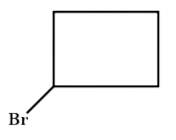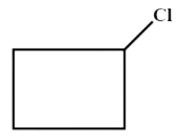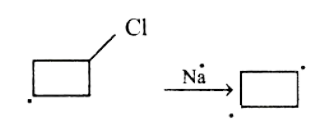
What would be the product formed when 1−bromo−3−chlorocyclobutane reacts with two equivalents of metallic sodium in the ether?
A . 1-Bromocyclobutane

B . 1 - Chlorocyclobutane

C . Cyclobutane

D . Bicyclo ( 1 , 1 , 0 ) ) butane

Answer
222k+ views
Hint: In this question, intramolecular Wurtz reaction is taking place. With the help of radical species R, the Wurtz reaction entails the transfer of halogen and metal in order to create a carbon-carbon bond that results from a nucleophilic substitution process. The process involves reacting alkyl halides with metallic sodium in the presence of dry ether to produce higher alkanes.
Wurtz reaction equation:
R-X + 2Na + X-R→ R–R + 2NaX, where X = halogen (Cl, Br, I)
Complete step by step solution:
Given that 1−bromo−3−chlorocyclobutane reacts with two equivalents of metallic sodium in the ether.
In the first step, Na will attack the Bromine-Carbon bond and a carbanion will be formed on the chlorocyclobutane.

After the formation of carbanion, Na will attack the Chlorine-Carbon bond and another carbanion will be formed on the chlorocyclobutane.

The formation of two carbanions on a 4-membered ring is very unstable and hence the two carbanions join to form a bond, and thus form Bicyclo ( 1 , 1 , 0 ) butane

Hence, the overall chemical reaction when 1−bromo−3−chlorocyclobutane reacts with two equivalents of metallic sodium in the ether is:

Thus, Option (D) is correct.
Note: A BrCl molecule is removed in this intramolecular Wurtz reaction, and a Carbon-Carbon bond is created, producing a bicyclic compound. The order of reactivity of alkyl halides in Wurtz reaction is R-I(alkyl iodide) >R-Br(alkyl bromide) >R-Cl(alkyl chloride), because Carbon-Bromine bond is weaker than Carbon-Chlorine bond. Hence. Wurtz reaction will take place with C-Br bond in the first step.
Wurtz reaction equation:
R-X + 2Na + X-R→ R–R + 2NaX, where X = halogen (Cl, Br, I)
Complete step by step solution:
Given that 1−bromo−3−chlorocyclobutane reacts with two equivalents of metallic sodium in the ether.
In the first step, Na will attack the Bromine-Carbon bond and a carbanion will be formed on the chlorocyclobutane.

After the formation of carbanion, Na will attack the Chlorine-Carbon bond and another carbanion will be formed on the chlorocyclobutane.

The formation of two carbanions on a 4-membered ring is very unstable and hence the two carbanions join to form a bond, and thus form Bicyclo ( 1 , 1 , 0 ) butane

Hence, the overall chemical reaction when 1−bromo−3−chlorocyclobutane reacts with two equivalents of metallic sodium in the ether is:

Thus, Option (D) is correct.
Note: A BrCl molecule is removed in this intramolecular Wurtz reaction, and a Carbon-Carbon bond is created, producing a bicyclic compound. The order of reactivity of alkyl halides in Wurtz reaction is R-I(alkyl iodide) >R-Br(alkyl bromide) >R-Cl(alkyl chloride), because Carbon-Bromine bond is weaker than Carbon-Chlorine bond. Hence. Wurtz reaction will take place with C-Br bond in the first step.
Recently Updated Pages
Types of Solutions in Chemistry: Explained Simply

States of Matter Chapter For JEE Main Chemistry

Difference Between Alcohol and Phenol: Structure, Tests & Uses

Conduction Explained: Definition, Examples & Science for Students

Balancing of Redox Reactions - Important Concepts and Tips for JEE

Atomic Size - Important Concepts and Tips for JEE

Trending doubts
JEE Main 2026: Application Form Open, Exam Dates, Syllabus, Eligibility & Question Papers

Derivation of Equation of Trajectory Explained for Students

Hybridisation in Chemistry – Concept, Types & Applications

Understanding the Angle of Deviation in a Prism

How to Convert a Galvanometer into an Ammeter or Voltmeter

Degree of Dissociation: Meaning, Formula, Calculation & Uses

Other Pages
Solutions Class 12 Chemistry Chapter 1 CBSE Notes - 2025-26

NCERT Solutions For Class 12 Chemistry Chapter 1 Solutions - 2025-26

The D and F Block Elements Class 12 Chemistry Chapter 4 CBSE Notes - 2025-26

NCERT Solutions for Class 12 Chemistry Chapter Chapter 7 Alcohol Phenol and Ether

NCERT Solutions ForClass 12 Chemistry Chapter Chapter 8 Aldehydes Ketones And Carboxylic Acids

JEE Advanced Marks vs Ranks 2025: Understanding Category-wise Qualifying Marks and Previous Year Cut-offs




